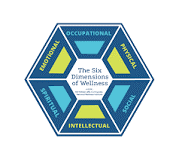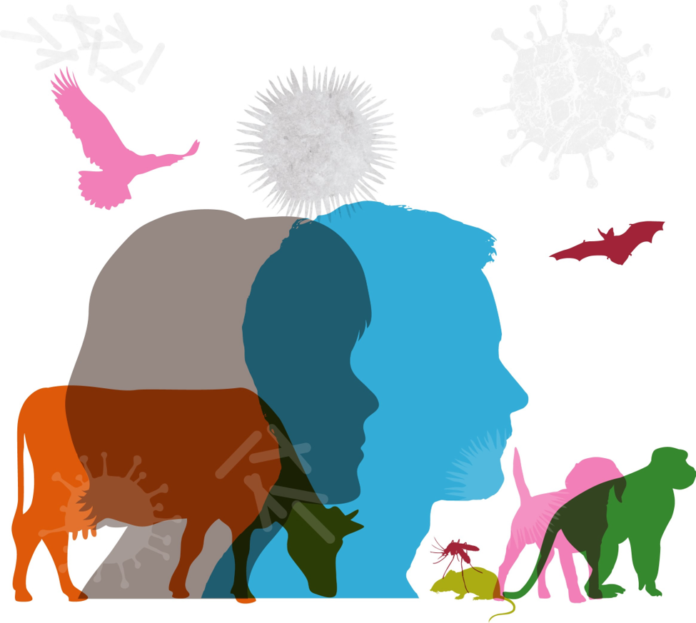One World, One Health: Prevent Zoonoses
| Dr. Alok Kumar Yadav Livestock Officer CCS- National Institute of Animal Health Baghpat-250609 (Uttar Pradesh) India
|
 |
The new concept, “One World, One Health,” is based on the understanding that humans, animals, and the environment are inextricably linked, indicating that the world has suddenly realized the interrelation between ecology, animal diseases, and public health, striving to restore and maintain harmony and synergy.
One Health (OH) is an approach, focusing on emergent infectious diseases, which looks at health in the context of human, animal and environment relationships. Governments worldwide through the International Ministerial Conferences on Avian and Pandemic Influenza (IMCAPI) meetings have made a commitment to OH. There is unanimous agreement from the international organizations to the community level that this is a necessary approach in an increasingly populous world. It is a world, however, in which professions have moved to specialization and expertise within their own realm rather than in collaboration and cross discipline. This chapter reports on the operationalization of OH to date and consideration of the forward path in examination of the key areas of: leadership, relationships, infrastructure, skills and capacity, communication and technology, and resources.
Why the One Health approach?
Animals and humans are infected by many of the same microorganisms because they live in a shared ecosystem. For example, most zoonotic diseases, such as rabies, anthrax and brucellosis, can be effectively prevented in humans by controlling an animal source of the causative agents.
What is the One Health approach to control zoonoses?
The One Health Zoonotic Disease Prioritization (OHZDP) process uses a multisectoral, One Health approach to prioritize zoonotic diseases of greatest concern that should be jointly addressed by human, animal, and environmental health sectors in a country, region, or other area.
What is the One Health one world concept?
One Health is an integrated, unifying approach that aims to sustainably balance and optimize the health of people, animals and ecosystems. It recognizes the health of humans, domestic and wild animals, plants, and the wider environment (including ecosystems) are closely linked and inter-dependent.
How can we control and prevent zoonoses?
Wash hands before and after animal handling. Do not eat or drink in the animal housing areas. Wear coveralls, farm-specific clothing, or laboratory coats when handling animals. Avoid handling sick animals or animals with lesions unless gloved.
What is the first and best line of defense against zoonotic diseases?
Veterinarians are the first and best line of defense against animal diseases that could threaten public health and our national security. They prevent and treat zoonotic diseases—diseases that can affect both animals and people from rabies to avian flu.
What is the benefit of One Health?
The One Health approach can: Prevent outbreaks of zoonotic disease in animals and people. Improve food safety and security. Reduce antibimicrobial resistant infections and improve human and animal health.
What is the role of One Health?
One Health is an integrated, unifying approach that aims to sustainably balance and optimize the health of people, animals and ecosystems. It recognizes that the health of humans, domestic and wild animals, plants, and the wider environment (including ecosystems) are closely linked and interdependent.
What is the need of One Health?
The One Health approach helps protect the health of all living beings by bringing experts across fields together to solve problems threatening humans, animals, and the environment. But One Health is not just about zoonotic diseases.
What is the importance of zoonoses?
Zoonoses are illnesses and infections that spread spontaneously from animals to people. They account for over 70% of recently developing infectious illnesses. Meat from cattle is one of the main sources of red meat and essential element of human diet.
What factors contribute to zoonoses?
Human Behavior and Cultural Factors Social changes resulting in altered land and water-use patterns, intensified agricultural practices, deforestation and reforestation, and human and domestic animal encroachment on wildlife habitats also affect the movement of pathogens.
What is zoonosis disease?
Disease Transmitted from Animals to Humans. A zoonosis (zoonotic disease or zoonoses -plural) is an infectious disease that is transmitted between species from animals to humans (or from humans to animals).
What are the first 3 lines of defense against infection?
Not only do they have to breach physical and chemical barriers, they’ve got to dodge front-line cells and evade tools specially trained to seek and destroy them. The three lines of defense are barrier defenses,the innate immune system,and the adaptive immune system.
What are the different types of zoonoses?
Based on etiology, zoonoses are classified into bacterial zoonoses (such as anthrax, salmonellosis, tuberculosis, Lyme disease, brucellosis, and plague), viral zoonoses (such as rabies, acquired immune deficiency syndrome- AIDS, Ebola, and avian influenza), parasitic zoonoses (such as trichinosis, toxoplasmosis.
How many diseases are zoonotic?
Zoonotic diseases are very common. More than six of 10 known infectious diseases in peopleare spread between people and animals.
What is the second line of defense against disease?
The second line of defense is nonspecific resistance that destroys invaders in a generalized way without targeting specific individuals: Phagocytic cells ingest and destroy all microbes that pass into body tissues. For example macrophages are cells derived from monocytes (a type of white blood cell).
What are the examples of One Health?
The scope of One Health includes zoonotic diseases, antimicrobial resistance, food safety and security, vector-borne diseases that come from insect bites, environmental contamination, and other health threats shared by people, animals, and the environment.
What is the concept of One Health in India?
One Health is an integrating idea that brings different sectors together to solve the health, productivity, and conservation challenges and has major implications for India.
What is the One Health joint plan of action?
One Health Joint Plan of Action has been outlined in the plan to maintain antimicrobial effectiveness. It also concentrated on ensuring that antimicrobials had been described for responsible and judicious use in human, animal, and plant health.
Who introduced One Health concept?
The Wildlife Conservation Society (WCS) introduced the term “One World-One Health” in 2007 along with 12 recommendations (the Manhattan Principles) that focused on establishing a more holistic approach to preventing epidemic disease and maintaining ecosystem integrity.
What are the three components of One Health?
One Health consists of the triad of human health, animal health, and the environment, but the latter is often neglected, as evident from its absence or cursory mention in most of the initiatives mentioned.
What is the scope of One Health approach?
The One Health approach is particularly relevant for food and water safety, nutrition, the control of zoonoses (diseases that can spread between animals and humans, such as flu, rabies and Rift Valley fever), pollution management, and combatting antimicrobial resistance.
What is One Health project?
One Health is a collaborative, multisectoral, and transdisciplinary approach working at the local, regional, national, and global levels with the goal of achieving optimal health outcomes recognizing the interconnection between people, animals, plants, and their shared environment.
How much health is important in life?
Your health is at the center of your life. Every part of your life relies on you having good health. You cannot climb higher in all the other seven areas of your life if you do not have enough physical energy to devote to each of them.
Is health important in your life?
Keeping healthy is a key part of your life. It is important to stay healthy because it will free you of health issues later down the line. Keeping healthy will also help you keep free of chronic diseases, like heart disease and cancer.
What are the common zoonoses in India?
- Bacterial zoonoses :- e.g. anthrax, brucellosis, plague, leptospirosis, salmonellosis, lyme disease.
- Viral zoonoses :- e.g. rabies, arbovirus infections, KFD, yellow fever, influenza, CCHF.
- Rickettsial zoonoses :- e.g. murine typhus, tick typhus, scrub typhus, Q-fever.
What are zoonoses diseases in India?
Major public health zoonotic diseases in India include Rabies, Brucellosis, Toxoplasmosis, Cysticercosis, Echinococcosis, Japanese Encephalitis (JE), Plague, Leptospirosis, Scrub typus, Nipah, Trypanosomiasis, Kyasanur forest disease (KFD) and Crimean-Congo haemorrhagic fever (CCHF).
Who is at risk for zoonotic disease?
However some groups of people are at higher risk of getting zoonotic diseases. This includes children younger than 5, adults older than 65, and people with weakened immune systems.
What are the 4 main groups of zoonoses?
Zoonoses can be classified according to the etiologic agent – viral, bacterial, parasitic, mycotic, or unconventional (prions).
What are the impacts of zoonoses?
Zoonotic diseases decrease the availability of food creating local and international trade barriers. Besides animal production, livestock keepers in rural areas often need their animals for other activities, such as an ox for ploughing or a donkey to take fruits to the market. A sick animal is of no use.
What are the causes of disease?
Infectious diseases are illnesses caused by harmful organisms (pathogens) that get into your body from the outside. Pathogens that cause infectious diseases are viruses, bacteria, fungi, parasites and, rarely, prions. You can get infectious diseases from other people, bug bites and contaminated food, water or soil.
What is zoonosis give example?
Zoonosis is another name for a zoonotic disease. This type of disease passes from an animal or insect to a human. Some don’t make the animal sick but will sicken a human. Zoonotic diseases range from minor short-term illness to a major life-changing illness.
What is the history of zoonoses?
Some experts have suggested that all human viral infections were originally zoonotic. Zoonoses are of interest because they are often previously unrecognized diseases or have increased virulence in populations lacking immunity. The West Nile virus first appeared in the United States in 1999, in the New York City area.
The One Health Zoonotic Disease Prioritization (OHZDP) process brings together representatives from human, animal, and environmental health sectors, as well as other relevant partners, to prioritize zoonotic diseases of greatest concern for multisectoral, One Health collaboration in a country, region, or other area. This process uses a transparent approach and incorporates equal input from all represented One Health sectors working at the human-animal-environment interface.
The goals of the OHZDP process are to use a multisectoral, One Health approach to
- Prioritize zoonotic diseases of greatest concern.
- Develop next steps and action plans to address the priority zoonotic diseases in collaboration with One Health partners.
The OHZDP process uses a multisectoral, One Health approach to prioritize zoonotic diseases of greatest concern that should be jointly addressed by human, animal, and environmental health sectors in a country, region, or other area.
Is One Health a theory?
Promoting an action-based, solutions-oriented approach, One Health: The Theory and Practice of Integrated Health Approaches highlights the lessons learned for both human and animal health professionals and students.
What are the core domains of One Health?
The Core Competencies are the foundation of the One Health approach, which include interdisciplinary teamwork, systemic thinking and a basic understanding of the approach.
What is the triad of One Health?
Based on the triad of healthy environment, healthy animals, healthy humans. “The key point is: We cannot look at human health in isolation. It is closely intertwined with the environment and the animal world, everything is interrelated,“ says Leendertz.
What is One Health approach?
One Health (OH) is an approach, focusing on emergent infectious diseases, which looks at health in the context of human, animal and environment relationships. Governments worldwide through the International Ministerial Conferences on Avian and Pandemic Influenza (IMCAPI) meetings have made a commitment to OH.
What are the 12 domains of health?
The 12 Care Domains are: Breathing, Nutrition – Food and Drink, Continence, Skin integrity (including tissue viability), Mobility, Communication, Psychological and emotional needs, Cognition, Behaviour, Drugs/Medication/Symptom control, Altered state of consciousness & Other.
What are the 5 domains of health and wellbeing?
There are five main aspects of personal health: physical, emotional, social, spiritual, and intellectual. In order to be considered “well,” it is imperative for none of these areas to be neglected.
Which domain of health is most important?
Number seven, and probably the most important, is our spiritual health. We know that people in the face of substantial emotional stress, social stress, even physical health stress, maintain a sense of wellness and connectedness and peace if their spiritual health is strong.
What are the Manhattan principles of one health?
The Manhattan principles highlight: links between humans, animals, and the environment, how these links are integral to understanding disease dynamics, and the importance of interdisciplinary approaches to prevention, education, investment, and policy development.
What is an example of a public health triad?
One example of how each member of the triad interacts is how the poor maintenance of livestock or agricultural fields by humans can aid in the spread of many animal and human diseases. Over the past several years, a number of different bacterial outbreaks have plagued vegetable growers in different part of world.
What is the triad of infectious disease model?

Among the simplest of these is the epidemiologic triad or triangle, the traditional model for infectious disease. The triad consists of an external agent, a susceptible host, and an environment that brings the host and agent together.
What is a health approach?
A public health approach aims to prevent or reduce a particular illness or social problem in a population by identifying risk indicators.
What is One Health pilot project?
The ‘One Health India’ program initiated by the Department aims to work with stakeholders from various sectors to improve livestock health, human health, wildlife health, and environmental health through technology and finance.
What is health one line?
Perhaps the most established modern day definition of health was termed by the World Health Organization (WHO) in 1948, when it stated: “Health is a state of complete physical, mental and social well-being and not merely the absence of disease or infirmity.
What are the 4 domains of health?
The four domains in which we can embody the Healthy Self are: physical, emotional, spiritual, and mental.
What are the 7 domains of life?
The CoE has adopted this holistic philosophy and incorporates these seven domains into all projects and programs:
- physical,
- emotional,
- environmental,
- social,
- intellectual,
- financial,
- and spiritual.
What are the 8 domains of health?
The poster presents a diagram of the eight dimensions of wellness: social, environmental, physical, emotional, spiritual, occupational, intellectual, and financial.
What are the 6 areas of wellness?

The National Wellness Institute promotes Six Dimensions of Wellness: emotional, occupational, physical, social, intellectual, and spiritual. Addressing all six dimensions of wellness in our lives builds a holistic sense of wellness and fulfillment.
Essential Issues and Challenges for Putting One Health into Practice:
While there has been wide-ranging commitment to the One Health approach for addressing complex health problems by a large number of national and international organizations and professional bodies, its operationalization has so far proved to be challenging. Implementation is often a complex issue requiring collaboration between diverse and multi-disciplinary partnerships (Conrad et al. 2013). At a local or national level it often might be a matter of breaking down professional barriers through improved communication and incorporating information on OH and its benefits into professional training and university courses. At the international level it is usually much more difficult and can be hindered by dysfunctions which characterize current forms of global health governance (Lee and Brumme 2012).
Definitions and Scope:
There is no single, accepted definition of OH, but the most frequently used definition is that developed by the AVMA: The integrative effort of multiple disciplines working locally, nationally, and globally to attain optimal health for people, animals and the environment. (King et al. 2008). The breadth and scope of OH, however, makes it difficult to find a definition that covers all aspects, and indeed the lack of consensus in definition gives the OH approach much greater flexibility. Increasingly OH is considered to be systemicbased with its scope of practice broad and growing, ranging from a specific zoonosis focus to a wide multidisciplinary ecosystem approach with a very broad canvas. However, the price for flexibility even in the field of emerging infectious disease (EID) has been diffusion, fragmentation and duplication of effort, and there is a strong argument put forward that it is timely for a unified international voice and structure to counteract these impacts (Lee and Brumme 2012)
References:
- Lee K, Brumme Z (2012) Operationalizing the one health approach: the global governance challenges. Health Policy Plan 28:778–785
- King L, Anderson L, Blackmore C (2008) Executive summary of the AVMA one health initiative task force. J Am Vet Assoc 233:259–260
- Conrad PA, Meek LA, Dumit J (2013) Operationalizing a one health approach to global health challenges. Comp Immunol Microbiol Infect Dis 36:211–216


